Bekim Gashi had paid for his bottle of water at the gas station shop and was heading toward the door when his eyes met those of a very familiar face. He pulled himself together, disregarded the greeting and left the store.
The unwanted encounter two years ago, at one of the usual stop-off points somewhere near Niš in Serbia, just adds to the many twists of fate that Gashi has experienced during his turbulent life. He was on his way back to Prishtina, while the other traveler, Pavle Gavrilović, was returning to his home in the southern Serbian city of Leskovac.
In recent years, Gashi has been forced to master the skill of self control. Any expression other than nonchalance would be like a defeat to him, a sign that he was falling for Gavrilović’s provocation. But Gashi still cannot get rid of the frustration at seeing Gavrilović acting amicably. It was already too much having to face him at all — and it was the second time that day.
The first time, hours earlier, had been when Gashi and Gavrilović had stood face to face in a Belgrade courtroom, at the War Crimes Chambers of the Higher Court in Belgrade: Gashi as a witness and victim at the trial of what is known as the ‘Tërnje case,’ and Gavrilović as one of two defendants for war crimes.
“No one should remain alive in the village,” Gavrilović is alleged to have said before Serbian forces broke into Tërnje on March 25, 1999. Gashi’s mother and four sisters were killed in the massacre — all of them remain missing to this day.
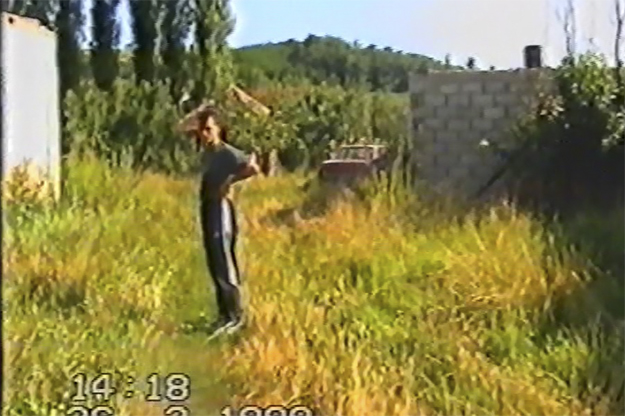
Bekim Gashi’s mother, four sisters, and 17 members of his extended family were killed by Serbian forces in the village of Tërnje in March 1999. Photo: Still image from home video (June 1999).
In November 2013, the Office of the War Crimes Prosecutor in Serbia filed an indictment against Gavrilović and Rajko Kozlina for war crimes against a civilian population. It states that on that fateful March day, alongside other members of the Logistics Battalion of the 549th Motorized Brigade of the Yugoslav Army, they killed at least 27 civilians.
The victims were all residents of Tërnje and other surrounding villages, near Suhareka in Kosovo, all older men, women, and children, including a four-year-old boy. As part of his alleged role in the crime, Kozlina stands accused of shooting one old man in the head in order to show the other soldiers how to shoot civilians.
At that time, Gavrilović was the commander of the Logistics Battalion, while Kozlina was a platoon commander. Both were still soldiers on active duty in the Serbian Army at the point that the indictment was filed.
Following the filing of the indictment, human rights NGO the Humanitarian Law Center sent a request to then Serbian Army Chief of General Staff, Ljubiša Diković — himself accused of war crimes — asking him to suspend those accused of committing war crimes from military service, in line with Serbia’s Law on the Armed Forces. However, Kozlina remains part of the Serbian Army, while Gavrilović has subsequently retired.
Reliving the horror
Since 2013, Gashi has been one of a number of eyewitnesses to have travelled often to Belgrade to take the stand as witnesses at the trial. But even when not required to give testimony, Gashi hasn’t allowed himself to skip a single hearing: It’s important for him to hear every witness testimony from former Serbian forces as he attempts to collect all the missing pieces of the massacre and to find out any information about what happened to the bodies of his family members.
“It’s a trip with many challenges,” Gashi says. “My family got killed once, and I get killed each time I go there. It’s very difficult to hear them talking [about the massacre].”
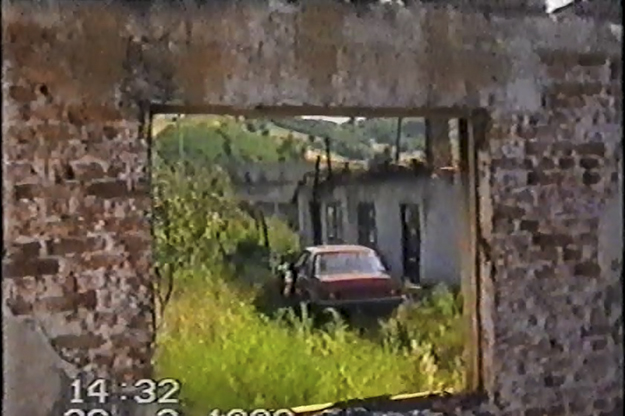
Gashi’s house was one of many razed to the ground by Serbian forces in the Tërnje massacre. Photo: Still image from home video (June 1999).
But for Gashi, who works at the Tax Administration in Prishtina, even the weekends spent with his wife and children at his family house in Tërnje trigger difficult memories.
Gashi’s house is located amongst two other houses belonging to his extended family members. All three were burnt to the ground by Serbian forces on the tragic day of the massacre. The large reconstructed houses with their neatly kept gardens hardly allude to the traumatic past. Only a huge pear tree and a well survived the fire, both still stoically standing as silent witnesses of the horror.
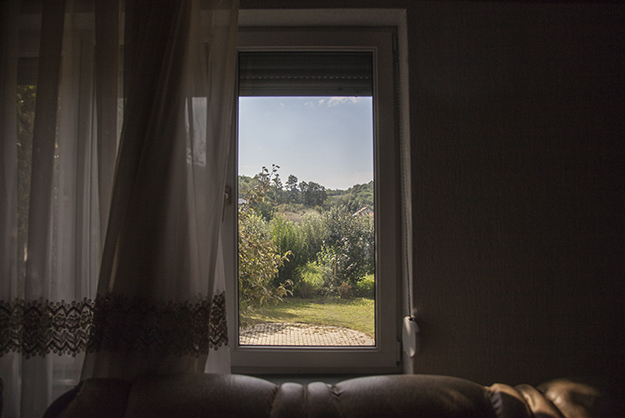
Gashi’s house has been completely reconstructed, but it still brings back haunting memories. Photo: Majlinda Hoxha / K2.0.
As soon as one steps into the house’s living room, the pictures hanging on the wall are a stark reminder of Gashi’s never ending sadness and struggle. From left to right, the five portraits immediately grab the attention in the spacious room: Blerta, 15; Lumturije, 17; Hyra, 57; Selvete, 27; and Luljeta, 31.
With his father having passed away in 1988, Gashi and his two youngest sisters were raised by their mother and older sisters, creating a deep attachment between the siblings. “I’ve been through so many things, but it always seems like they are with me,” Gashi says. “I think they are my guardian angels.”
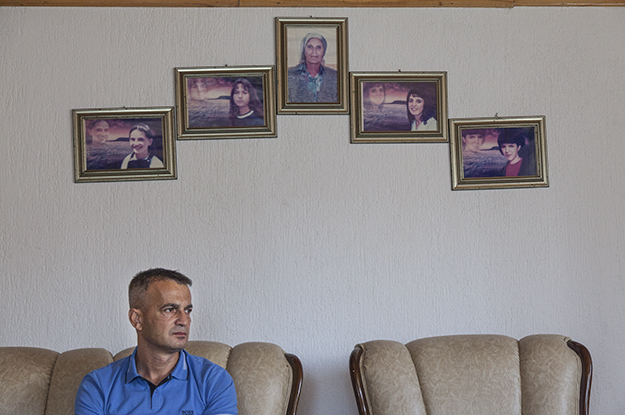
Portraits of Gashi’s missing mother and four sisters form the focal point of the living room in his house in Tërnje. Photo: Majlinda Hoxha / K2.0.
On March 22, 1999, two days before NATO launched its bombing campaign that would ultimately bring the war in Kosovo to an end, 24-year-old Gashi returned home from Prishtina, where he was studying economics within the Kosovar Albanian parallel education system.
Luljeta, his oldest sister and a teacher, used to encourage him during the moments when he struggled for motivation to continue his studies during such unsteady times. “Don’t you dare quit your studies!” she would say to him. “One can never leave school. Kosovo will be OK one day and you’ll need your education.”
On the eve of the NATO bombing, Gashi’s mother and sisters tried to persuade him to flee and seek sanctuary elsewhere, because as the only man in the house, they felt he would be the first target of any attack by Serbian forces. “You have to leave the house,” he remembers being told. “They don’t do anything to women. We can stay alone.”
As the first NATO planes appeared in the sky on the evening of March 24, he ate with his family for what would prove to be the final time. “It’s a war. Whoever can leave must do so and survive somehow,” his mother said while watching the news and anticipating the insecure future. “Don’t look at saving each other, just take care of your own selves. Whoever lives, lives.”
Gashi spent the early hours of the morning awake along with his two older sisters, taking it in turns to look out of the window for any sight of Serbian forces. Then, as dawn was breaking and the night sky was beginning to turn a lighter shade, Luljeta went outside to bring in firewood from the balcony. When she looked up, she saw to her horror that the hill opposite the house was full of men in uniforms.
“We’re besieged by the army on all sides!” she screamed.
According to witness testimony from the International Criminal Tribunal for the former Yugoslavia (ICTY) trial of Slobodan Milošević, the Logistics Battalion arrived at a hill above Tërnje, around 4 o’clock in the morning and directed its three-barrelled anti-aircraft gun at the village. All operations appeared to be almost exclusively military, as only one policeman — who was familiar with the terrain — joined the platoons, which consisted of up to 100 soldiers.
Gavrilović is said to have asked whether the soldiers were ready for action before motioning with his hand toward Tërnje, signalling those operating the anti-aircraft gun to start firing at the village.
Amidst the sound of heavy artillery shelling all around, the five women went to seek shelter in an uncle’s house to the left, which sheltered mainly women and children, both those from the family and others who were internally displaced. Gashi went with the men across the small village road to the rear, to the third family house. Within no time at all, he saw the army coming down the hill burning everything along the way: trucks, yards — and houses.
Back at the ICTY, protected witness K-41 — a Yugoslav army conscript — recalled soldiers setting a haystack ablaze, before going into houses and setting them on fire, one by one, as villagers attempted to flee. It was at this point that the protected witness recalled how Kozlina ordered a soldier to shoot an elderly man.
“I can’t do it,” the soldier is said to have replied, before Kozlina killed the old man himself with a burst of gunfire to his head, saying, “This is how it’s done.”
After coming to the house with Gashi’s sisters and mother inside, K-41 remembered seeing the curtains in one of the windows move. They broke in and forced all of those inside out into the yard at gunpoint. Kozilina is then said to have given the order to shoot them all.
In the middle of the chaotic shootings, Gashi somehow managed to climb onto the roof. What he saw next will be seared into his memory for the rest of his life: The bodies of his four sisters and the others who were sheltering at his uncle’s house opposite lay strewn across the yard. His mother, still standing, walked a few steps and asked for water, before falling to the ground.
Gashi’s mother and sisters were among 16 persons killed in that yard. No remains from any of the bodies have ever been found.
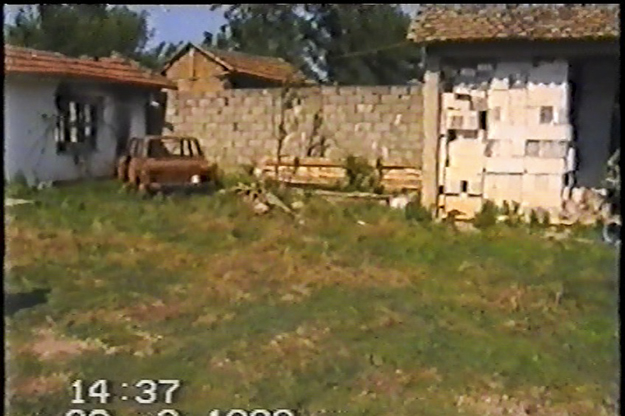
Gashi will never forget the horrific scenes he witnessed in his uncle’s front yard. Photo: Still image from home video (June 1999).
Between March 24 and June 10, 1999, in areas controlled by the 549th Motorized Brigade of the Yugoslav Army — including the areas around Prizren, Gjakova, Rahovec and Suhareka — 2,174 Kosovar Albanian civilians were killed by Serbian forces. The President of the Federal Republic of Yugoslavia at that time, Slobodan Milošević, decorated the 549th Motorized Brigade with the Order of the People’s Hero for its heroic defense of the country.
Gashi himself managed to escape the Serbian forces, but 22 of his extended family members were killed that day. “I think I had seven souls,” he says.
Until June 1999, when Serbian forces withdrew from Kosovo marking the end of the war, Gashi moved from mountain to mountain, crossing rivers and passing through villages in order to escape Serbian forces. He returned home after eleven weeks with the aim of burying the bodies. But he found only his mother’s scarf and a pair of one of his sister’s shoes. He was told that the Serbian forces had removed the bodies to an unknown place.
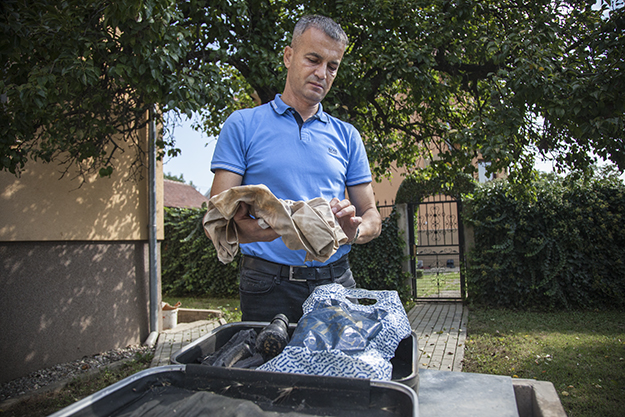
Gashi has kept his mum’s scarf and sister’s shoes as sacred mementos of his missing loved ones. Photo: Majlinda Hoxha / K2.0.
Gashi goes silently into his basement and returns to the yard with a dusty old suitcase. Slowly, he takes out the beige scarf and the pair of shoes. He’s never reopened it before, a step too painful and a burden he had wanted to keep for himself.
“I’ve never told anybody I have this,” he says, emotionally. “I didn’t want to also transmit the pain to other people.”
Quest for information and justice
In the weeks, months and years that followed, Gashi’s fixation on finding the bodies of his family members saw him travel thousands of kilometers across Kosovo over dozens of trips. In July 1999, he was present at the excavation of a mass grave in the village of Breznë, Dragash, checking to see if the mortal remains of six victims from the Tërnje massacre were those of his loved ones — they weren’t.
On 18 separate occasions, he made the 200 kilometer round trip to Merdare. It’s here, at the Kosovo-Serbia border, that the families of missings persons would wait each time Serbia returned the bodies of Kosovar Albanian civilians to Kosovo after being exhumed from Serbian mass graves.
In one of his quests for his relatives at Merdare, Gashi met with the executive director of the Humanitarian Law Center (HLC) in Kosovo, Bekim Blakaj. The meeting persuaded Gashi to take his fight to the Serbian judicial system and to attempt to see the perpetrators in front of a judge, putting him on course for a long wait for justice.
Soon after, Gashi got in touch with Nataša Kandić, the founder of HLC-Serbia, which has documented atrocities during the Kosovo war and has been representing victims in front of Serbian courts.
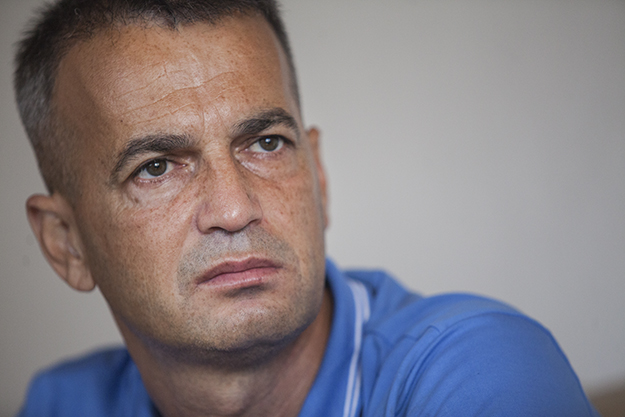
Gashi’s desperation to find any piece of information linked to the whereabouts of his missing family members has taken him to Belgrade’s Special War Crimes Chambers on numerous occasions. Photo: Majlinda Hoxha / K2.0.
After taking evidence from eyewitnesses, state documents and ICTY records, in May 2008, HLC filed a criminal complaint against 11 individuals, including Pavle Gavrilović and Rajko Kozlina, for the crimes committed in Tërnje. They were mostly members of the 549th Motorized Brigade, but also included members of the Ministry of Internal Affairs of the Republic of Serbia, who according to HLC, acted in accordance with a preconceived plan and agreement to commit these murders, thereby becoming criminally responsible for committing a war crime against the civilian population.
HLC highlights that provisions of international criminal law regulates the individual criminal responsibility of immediate perpetrators of crimes, their military commanders and political leaders who ordered the commission of crimes. International humanitarian law also includes the principle of command responsibility, according to which superior officers who fail to undertake measures necessary to prevent the commissioning of crimes, or to punish the perpetrators, should also be held accountable.
Judicial authorities in Serbia have yet to apply the principle of command responsibility in any war crimes case from the 1990s.
The criminal complaint in the Tërnje case included Božidar Delić, the commander of the 549th Motorized Brigade. However, when the War Crimes Prosecutor finally issued an indictment, it included only Kozlina and Gavrilović, whereas Delić has testified as a defense witness at the trial.
“It is … a problem in this case, because Delić, who is responsible for his unit and the crimes committed by the members of his units, should also be indicted for the crime,” Ivana Žanić from HLC-Serbia says. “I think that the War Crimes Prosecutor didn’t investigate his involvement in these crimes, because it doesn’t want to investigate command responsibility, only direct perpetrators.”
Žanić says that there is a reluctance to investigate high ranking officials, due to political reasons. “Some of them are still in high positions in institutions,” she says. “For example Ljubiša Diković, who [until this month was] chief of staff of our army. You know, everything is clear.”
The Prosecution’s indictment also came five years after HLC submitted its criminal complaint, and more than a decade after information about the perpetrators had first become public, in 2002.
Since the start, the trial has been characterized by delays. The first preliminary hearing was finally held in April 2014, with the first main trial session not scheduled for almost another year, in February 2015.
HLC says that the following five main trial sessions were then delayed owing to the illness of the judge, the failure of the injured parties to appear before the court (as the court had sent them the witness invitations too late), and claimed health problems of one of the accused, Kozlina. During the four years since the indictment was issued, only nine trial days have been held out of 22 scheduled.
In 2017, HLC filed a constitutional complaint on behalf of the victims in the Tërnje case for violation of their right to a trial within a reasonable timeframe. This complaint is still being processed.
“That is not good for victims, because they don’t have faith in the Serbian judicial system, the trial, and everything connected to the trial,” Žanić says.
According to an HLC press release, the Tërnje case is “a paradigm of war crimes trials in Serbia”; all accused persons remain at liberty while defending themselves, and hearings are scheduled months apart. It also points out that the number of crimes committed during the Kosovo war and their severe nature, as well as the number of perpetrators now living in Serbia, is completely at odds with the desperately low number of indictments issued to date.
Even with the complexity of the Tërnje crimes, and the almost two decades that have passed since they were committed without receiving any clue as to what happened to the bodies of his loved ones, Gashi still has a sense of anticipation each time he travels to a hearing. On many occasions he has come back disappointed after the hearing has failed to be held.
In the strange environment where victims and perpetrators oppose each other, Gashi still relives every detail when some witnesses retell the facts of the crime, and feels a sense of outrage when other witnesses deny them.
“I never thought that this would be a fair trial, or that they would receive the punishment they deserve,” Gashi says. “Even if they get a life sentence, I will never have any peace until [my family] are found. I entered this journey in the hope that I would find something. The most difficult part is when I get home from Belgrade and my children open the door and ask me, ‘Did you find them?’”K
Edited by Jack Butcher.
Feature image: Majlinda Hoxha / K2.0.

Back to monograph










Thats how terorist end. When Usa,Gb and France army did this, then its fight against terorism, when serbs did, than its war crime.